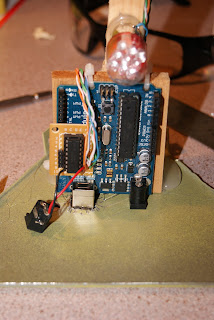I finally finished the traffic light! Once my paint had dried, I needed to figure out a way to make the lights have color when they were off but light up from the LEDs. I had originally thought about using theatrical lighting gels but they were too dark and ate up too much of my light. So I decided to have a light pattern printed in red, green and yellow at Staples on overhead transparencies. It looked great and only cost $6.
Next, I had to mount the LEDs inside the light. To do this, I attached them to a long, skinny piece of wood and hung it from the removable top. The wood is attached to the top using a screw and some glue. I made a wooden bracket to hold the electronics inside the light and cut holes for the ports in the top.
With all of the electronics assembled, all that was left to do was to put it all together and test it. When I tested it for the first time I found that the green light leaked into all of the other colors, which reduced the effect. This was easily fixed by making a cardboard divider. In the end, it all worked fine. I am very impressed at how well it turned out.
Works Cited:
"How Light Emitting Diodes Work"-How Stuff Works
-from "http://electronics.howstuffworks.com/led.htm" , accessed 14/12/2010













